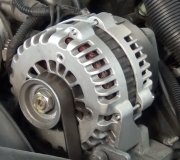Tell the person who removed the battery cable that doing so could have easily damaged multiple computers on your car. That was a trick done a long time ago by mechanics who didn't understand how these simple systems work or how to properly diagnose them. There were no sensitive computers on cars in those days. Today a mechanic caught doing that will immediately be invited to look for work somewhere else.
To add to the misery, removing a battery cable with the engine running can not prove anything. The alternator can be defective, yet the engine remains running, or the alternator can be perfectly fine, but the engine will stall when the cable is disconnected. It all depends on how the voltage regulator responds to the high points and low dips that result in the alternator's output voltage when the battery isn't in the circuit to smooth out that "ripple".
What can save you is all generators are very inefficient at low speeds. The battery is needed to help the voltage regulator maintain a steady, safe voltage, At higher engine speeds, if the battery is disconnected, system voltage can easily go higher than 30 volts. That will destroy computers and burn out any bulbs that are on.
The proper way to test the charging system requires a professional load tester, but you can start the testing yourself with just a digital voltmeter. If you don't have one, Harbor Freight Tools has a perfectly fine one for $7.00. You can find them at Walmart and any hardware store too. This article shows how to use one:
https://www.2carpros.com/articles/how-to-use-a-voltmeter
They're using a meter with "auto-ranging". That's an expensive feature you don't need. I can help you set up a regular meter if needed.
This article shows how we test charging systems:
https://www.2carpros.com/articles/how-to-check-a-car-alternator
Start by measuring the battery's voltage with the engine not running. If you find it's close to 12.6 volts, it's fully-charged. If it's closer to 12.2 volts, it's good, but nearly fully discharged. Charge it at a slow rate for a couple of hours with a small portable charger.
Next, measure the battery voltage again with the engine running. Now we want to see between 13.75 and 14.75 volts. If it stays near 12.6 volts or less, the charging system is not working. If the voltage is within the acceptable range, that means it is okay to perform the rest of the tests, but those require the professional load tester. That will test if the alternator can develop the amount of current it is rated for. There's three possible results. It will develop that rated current, it will develop no current, or it will only be able to develop exactly one third of its rated current. Your vehicle was available with a 117 amp or a 136 amp alternator. All alternators have at least six "diodes", and develop three-phase output which is very efficient. If you have the 117 amp unit and it has one defective diode, it will only be able to develop around 35 - 40 amps. That is usually not enough to run the entire electrical system under all conditions. The battery has to make up the difference until it slowly runs down over days or weeks.
With the one bad diode, one of the three output phases will be missing. That makes ripple voltage very high. That's what the professional load testers look for. There are a few models that can make printouts of the results. Those actually list ripple voltage as a voltage. For all the other testers, they just indicate whether ripple voltage is "high" or "low" with a series of lights on a relative bar chart. High ripple voltage with a maximum of only one third of the expected output current identify the failed diode.
I don't think this is the case, but if you do find battery voltage doesn't come up to 13.75 - 14.75 volts with the engine running, the system can be diagnosed by taking three voltage readings on the back of the alternator. One test point is the fat output wire that's bolted to the stud. The other two are on two very small studs near the middle of the rear housing. They are metal tabs that go into a black plastic block. You will find 0 volts on both of them with the engine not running. Those readings must be taken with the engine running. The nuts on those two studs commonly get rusty and make it difficult to get a voltage reading.
You may need to scratch the voltmeter's probes a little to cut through that rust. Tell me those three readings if it comes to that, then we'll figure out where to go next.
Let me know what you find with these tests.
Friday, July 21st, 2023 AT 7:39 PM



